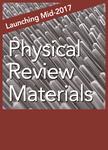版权所有:内蒙古大学图书馆 技术提供:维普资讯• 智图
内蒙古自治区呼和浩特市赛罕区大学西街235号 邮编: 010021

作者机构:Department of Materials Science & Engineering Texas A & M University College Station Texas 77843 USA Department of Electrical and Computer Engineering Texas A & M University College Station Texas 77843 USA Department of Mechanical Engineering Texas A & M University College Station Texas 77843 USA
出 版 物:《Physical Review Materials》 (Physic. Rev. Mat.)
年 卷 期:2018年第2卷第11期
页 面:113803-113803页
核心收录:
基 金:Air Force Office of Scientific Research, AFOSR, (AFOSR-FA9550-78816-1-0180) Experiment Design, (NSF-CISE-1835690, NSF-CCF-1553281) National Science Foundation, NSF, (1729350, 1835690)
主 题:Mechanical & acoustical properties Density functional theory High-throughput calculations Machine learning Numerical techniques
摘 要:The accelerated exploration of the materials space in order to identify configurations with optimal properties is an ongoing challenge. Current paradigms are typically centered around the idea of performing this exploration through high-throughput experimentation/computation. Such approaches, however, do not account for—the always present—constraints in resources available. Recently this problem has been addressed by framing materials discovery as an optimal experiment design. This work augments earlier efforts by putting forward a framework that efficiently explores the materials design space not only accounting for resource constraints but also incorporating the notion of model uncertainty. The resulting approach combines Bayesian model averaging within Bayesian optimization in order to realize a system capable of autonomously and adaptively learning not only the most promising regions in the materials space but also the models that most efficiently guide such exploration. The framework is demonstrated by efficiently exploring the MAX ternary carbide/nitride space through density functional theory (DFT) calculations.